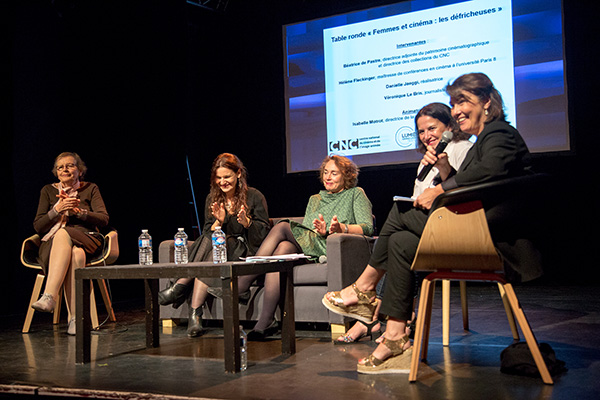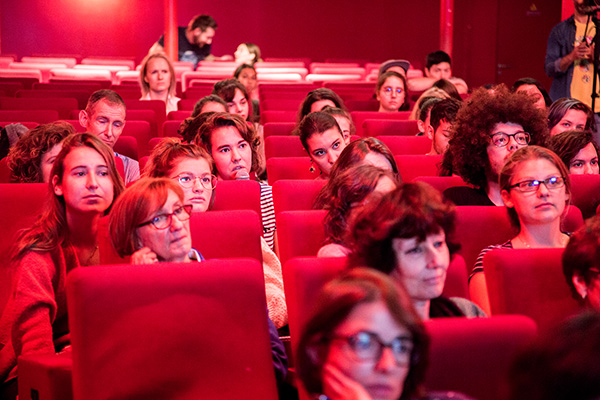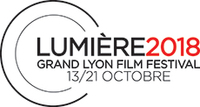CNC Round table
Unknown pioneers of cinema
POSTED ON OCTOBER 23, 2018
On the occasion of the 10th edition of the Lumière festival in Lyon and in partnership with Causette magazine, the CNC held a round table on Women and Cinema: Pioneers. Report.
They have innovated, experimented and invented; women directors, actresses or screenwriters have worked in the cinema from the very beginning, yet remain largely unknown. We are perhaps familiar with Alice Guy, Musidora, Lotte Reiniger or Loïe Fuller, but what about the others? Widely present across the board, they lost ground after the 1920s, restricted to specific trades. What remains of these trailblazers today? What legacy did they leave for other generations? Can we preserve their work, a long-forgotten heritage?

Copyright Institut Lumière / Bastien Sungauer
On the panel: Isabelle Motrot, host and moderator of the round table and Editorial Director of Causette magazine, filmmaker Danielle Jaeggi, Hélène Fleckinger, Associate Professor of cinema at the University of Paris 8, Béatrice de Pastre, Assistant Director of Film Heritage and Director of Collections at the CNC, and Véronique Le Bris, journalist, founder of Cine Woman magazine and the Alice Guy Prize.
Who are these pioneers?
Alice Guy, the first female director in film history, was passionate about technique. Contrary to stereotypes, the first women of cinema were involved in all facets of the profession. A stenographer for Léon Gaumont, Guy took lessons from an avant-garde photographer who taught her development, use of equipment and special effects. Curious about all genres of cinema, from documentaries to fiction, she had a keen sense of how to direct actors. Others, such as Lotte Reiniger of Germany or Elvira Notari of Italy, have played key roles in cinema history, but have subsequently been forgotten. Cinema history was principally written by men, for men, and taught in courses that failed to address the gender issue. Very few books offer a reflection on the history of cinema as seen through the lens of gender. Véronique Le Bris's "50 Femmes de Cinéma" is an exception; composed of fifty portraits of women in cinema, the book allows us to rediscover film history through a feminine prism, featuring heroines from all continents and of all trades: actresses, producers, directors, costume designers… championed by such women as Alice Guy, Kathryn Bigelow, Brigitte Bardot or Marlène Dietrich.

Copyright Institut Lumière / Bastien Sungauer
A dry spell
While in the early days, the film industry was relatively open to women, the 1930s marked the beginning of a drought. Fewer and fewer women became directors, producers or writers. In Germany, Lotte Reiniger was blacklisted by the fascist regime and forced to leave her country. Women were suddenly relegated to professions of scriptwriters, makeup artists or editors. "Why editors?” the panel is asked. The response: “Because editing machines looked like sewing machines.” Women did not make a comeback in key professions of cinema until the 80s, following the women’s liberation movement of the 70s. According to Hélène Fleckinger, 1968 was a pivotal year: after the general states of Cinema in May 1968, there was a call to democratize cinematographic means of expression, an awareness of the oppression of women in the cinema. This resulted in the appearance of a new technique, légère video, which allowed amateurs to access video production, making feminine voices heard. Women's rights activists seized upon these new film tools to gain autonomy; from production to editing, they were able to master all the links in the chain and create new images, reflecting women's points of view.
Agnès Varda explains how, taking the advice of Resnais, she began to go to the cinemas in the 50s. "I started to see beautiful films, monumental films; made by men. I said to women, "Learn all you can about camerawork, editing. I saw a company of technicians who did away with the idea that women did not have the right... It is not only the history of cinema, but also the history of society, that has changed. Of the two Palme d'or awards given to women, one was a tie (Jane Campion, the Palme d'or “winner” for The Piano in 1993, shared it with Mr. Kaige Chen) and my Palme d’or is an honorary one, which does not really count... Today the ball has moved forward, women choose to do things that they like."

Copyright Institut Lumière / Bastien Sungauer
Toward improving parity
Today, says Evelyne Laquit, the CNC is involved in film schools, particularly FEMIS, to ensure parity, especially in the production sector. But women graduates of FEMIS face a daunting future: why are only 20% of films made by women? In an attempt to answer this question, the CNC, at its Summit on Parity, Equality and Diversity (in September 2018), announced a study on the future of women graduates in cinema to understand the obstacles they face and support them with appropriate measures. Among other significant proposals announced at the Summit: the valorization and restoration of women's heritage films, as well as a bonus for films that reach parity in major positions of their film crew (directing, production management, cinematography, etc.). This bonus will represent 15% of the support granted to the film by the CNC.
#MeToo: a turning point in the history of cinema
What impact has #MeToo, it had on the place of women in cinema? For Hélène Fleckinger, the movement has profoundly changed the nature of teaching, particularly film analysis, as well as course themes and the films proposed. "A rape scene will never be analyzed as it was before," she explains.
The round table discussions of topics are so fascinating that we do not want it to end - but there will be others; the CNC foresees a series of similar forums that they plan to conduct at various film festivals.
Lise Pedersen

